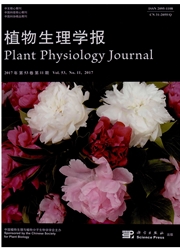

 中文摘要:
中文摘要:
低温、高盐、干旱等非生物胁迫严重影响花生(Arachis hypogaea)生长和产量,而对花生非生物胁迫的研究及抗性基因的挖掘较少。蔗糖转运蛋白(SUC或SUT)影响蔗糖的运输方向、速率和分配,其基因表达受多种因子的调控,包括内源激素、生物逆境和非生物胁迫等。本研究以花生品种‘花育33号’为试验材料,根据cDNA文库中已知的SUT基因全长序列设计引物,通过反转录PCR(RT-PCR)克隆到该基因,命名为AhSUT1。AhSUT1全长为1 861 bp,开放阅读框为1 563 bp,编码521个氨基酸。预测该基因编码的蛋白含有MFS保守结构域,可能定位于细胞质膜上。蛋白序列比对和进化树分析表明,花生与大豆(Glycine max)、蒺藜苜蓿(Medicago truncatula)、鹰嘴豆(Cicer arietinum)、豌豆(Pisum sativum)等豆科植物中的SUT序列相似性最高,亲缘关系最近。荧光定量PCR结果显示,AhSUT1在花生根中的表达受高盐胁迫特异诱导,说明该基因可能参与了花生对高盐胁迫的适应性调控;AhSUT1在花生根中受脱落酸(ABA)诱导,说明该基因对花生盐胁迫的调控可能是以依赖ABA的方式进行的。
 英文摘要:
英文摘要:
Peanut (Arachis hypogaea) growth and yield are strongly influenced by abiotic stresses such as drought, salt and cold. However, little has been done in the aspect of abiotic stress regulation and related genes screening in peanut. Sucrose transport protein (SUC or SUT) in plasmalemma impacts on transport direction, distributing efficiency and distribution of sucrose, and the expression of SUCs are greatly affected by various factors such as endogenous hormone, biotic stress and abiotic stress. In this article a sucrose transport protein (SUT) gene was cloned from the leaves of peanut (cultivar 'Huayu 33') using reverse transcription PCR (RT- PCR), and was designated as AhSUT1. The whole sequence of AhSUT1 is 1 889 bp and its open reading frame is 1 563 bp, encoding a polypeptide of 521 amino acids. Its protein was predicted to be located in plasma membrane, containing the conserved MFS domain. Multiple sequence alignments and phylogenetic analysis of SUT proteins indicate AhSUT1 is most similar with SUT (SUC) from Glycine max, Medicago truncatula, Citer ari- etinum and Pisum sativum. The results of real time RT-PCR show that the expression of AhSUT1 was induced distinctly in peanut roots during salt conditions, suggesting that AhSUTI may participate in the salt stress regulation of peanut. The expression of AhSUT1 was also induced by exogenous ABA in peanut roots, which indicates that AhSUT1 may regulate peanut salt stress resistance through ABA-dependent pathway.
 同期刊论文项目
同期刊论文项目
 同项目期刊论文
同项目期刊论文
 Validation of reference genes for gene expression studies in peanut by quantitative real-time RT-PCR
Validation of reference genes for gene expression studies in peanut by quantitative real-time RT-PCR Cloning and Functional Analysis of Three Diacylglycerol Acyltransferase Genes from Peanut (Arachis h
Cloning and Functional Analysis of Three Diacylglycerol Acyltransferase Genes from Peanut (Arachis h Dynamic Succession of Soil Bacterial Community during Continuous Cropping of Peanut (Arachis hypogae
Dynamic Succession of Soil Bacterial Community during Continuous Cropping of Peanut (Arachis hypogae 期刊信息
期刊信息
